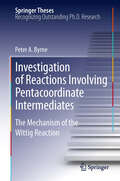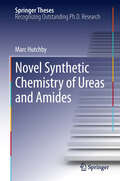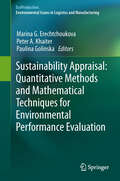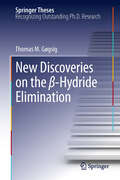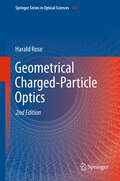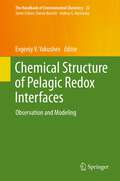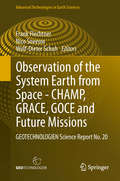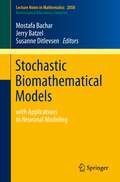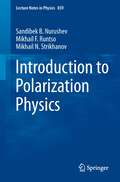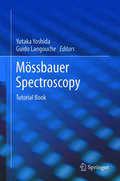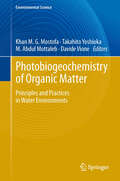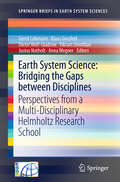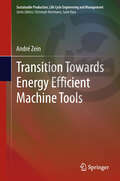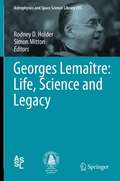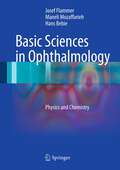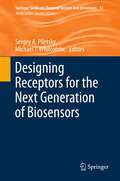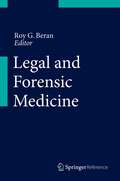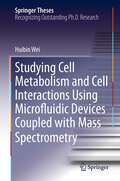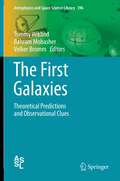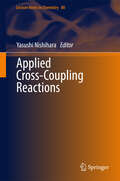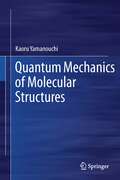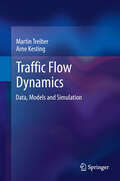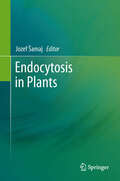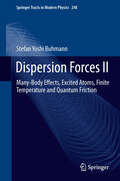- Table View
- List View
Investigation of Reactions Involving Pentacoordinate Intermediates
by Peter A ByrneIn this thesis, the author outlines the discovery of an effect common to representative examples of all Li salt-free Wittig Reactions. The implications of such a universally applicable effect are that all such Wittig reactions occur through the same mechanism. Although the Wittig reaction was first discovered in 1953, its reaction mechanism has never been definitively settled with many different variants proposed and disproved. The work in this thesis shows conclusively that for [2+2] cycloadditions all Wittig reactions occur by the same irreversible mechanism. In addition, the author also describes a new chromatography-free method for the removal of phosphine oxide from the alkene crude product of the Wittig reaction. The work in this thesis has led to several publications in high-profile journals.
Novel Synthetic Chemistry of Ureas and Amides
by Marc HutchbyIn this thesis, the author investigates the chemistry and application of molecules containing urea and amide bonds. These bonds are some of the strongest known and are fundamental to biological processes. The author describes his discovery that sterically hindered ureas undergo solvolysis at room temperature under neutral conditions. This is a remarkable finding, since ureas are inert under these conditions and a general rule of chemistry is that hindered substrates are less reactive. Remarkably, the author translates these results to the correspondingly sterically hindered amides. This thesis has resulted in a number of outstanding publications in high profile journals. The unique method for breaking urea and amide bonds developed in this study is likely to have far reaching consequences for biological protein manipulation.
Sustainability Appraisal: Quantitative Methods and Mathematical Techniques for Environmental Performance Evaluation
by Paulina Golinska Marina G Erechtchoukova Peter A KhaiterOne of the most important issues in developing sustainable management strategies and incorporating ecodesigns in production, manufacturing and operations management is the assessment of the sustainability of business operations and organizations' overall environmental performance. The book presents the results of recent studies on sustainability assessment. It provides a solid reference for researchers in academia and industrial practitioners on the state-of-the-art in sustainability appraisal including the development and application of sustainability indices, quantitative methods, models and frameworks for the evaluation of current and future welfare outcomes, recommendations on data collection and processing for the evaluation of organizations' environmental performance, and eco-efficiency approaches leading to business process re-engineering.
New Discoveries on the β-Hydride Elimination
by Thomas M. GøgsigThe work presented in Thomas M. Gøgsig's thesis deals with the discovery of new metal-catalyzed transformations ranging from Kumada-, Heck- and Suzuki-type reactions. The thesis starts with a formidable introduction to Pd-catalyzed cross-coupling reactions. New results have been obtained on: (i) Pd-catalyzed 1,2-migration reactions, (ii) Pd-catalyzed Heck reactions employing heteroaromatic tosylates, (iii) Ni-catalyzed Heck reactions, and (iv) Pd-catalyzed carbonylative Heck reaction. Metal-catalyzed cross-coupling reactions are today a highly competititve field (the 2010 Nobel Prize in Chemistry was awarded "for palladium-catalyzed cross couplings in organic synthesis", the 2001 and 2005 Nobel Prizes in closely related fields). Thomas M. Gøgsig obtained new results in his thesis that will help to improve the outcome of catalytic processes and improve their scope. The results will thus become key references for tomorrow's new applications. All chapters include insightful discussions and in-depth descriptions of the key principles of these new discoveries.
Geometrical Charged-Particle Optics
by Harald RoseThis second edition is an extended version of the first edition of Geometrical Charged-Particle Optics. The updated reference monograph is intended as a guide for researchers and graduate students who are seeking a comprehensive treatment of the design of instruments and beam-guiding systems of charged particles and their propagation in electromagnetic fields. Wave aspects are included in this edition for explaining electron holography, the Aharanov-Bohm effect and the resolution of electron microscopes limited by diffraction. Several methods for calculating the electromagnetic field are presented and procedures are outlined for calculating the properties of systems with arbitrarily curved axis. Detailed methods are presented for designing and optimizing special components such as aberration correctors, spectrometers, energy filters monochromators, ion traps, electron mirrors and cathode lenses. In particular, the optics of rotationally symmetric lenses, quadrupoles, and systems composed of these elements are discussed extensively. Beam properties such as emittance, brightness, transmissivity and the formation of caustics are outlined. Relativistic motion and spin precession of the electron are treated in a covariant way by introducing the Lorentz-invariant universal time and by extending Hamilton's principle from three to four spatial dimensions where the laboratory time is considered as the fourth pseudo-spatial coordinate. Using this procedure and introducing the self action of the electron, its accompanying electromagnetic field and its radiation field are calculated for arbitrary motion. In addition, the Stern-Gerlach effect is revisited for atomic and free electrons.
Chemical Structure of Pelagic Redox Interfaces: Observation and Modeling (The Handbook of Environmental Chemistry #22)
by Evgeniy V. YakushevOver the last few decades many studies have focused on the oxygen depletion of coastal and oceanic waters. An understanding of the processes involved is fundamental to assess the effects of global and climatic changes and to support an ecosystem approach to adaptive environmental management for coastal seas and ocean basins. This timely book presents the state-of-the-art of our knowledge of the nature and chemical structure of redox interfaces in a marine water column, oxygen depletion and connected processes. The structures of the redox layers, including the distribution of certain parameters and microbiological features, are described in detail. The volume also covers studies devoted to the interannual variability of some oxygen-depleted systems, modeling and new developments in observation techniques. In addition, it identifies remaining gaps in our knowledge of the cycling of chemical elements in changing redox conditions. The chapters are based on extensive observational data, collected by the authors during sea and shore expeditions, on archive data, and on a broad range of scientific literature.
Observation of the System Earth from Space - CHAMP, GRACE, GOCE and future missions
by Frank Flechtner Nico Sneeuw Wolf-Dieter SchuhSignificant advances in the scientific use of space based data were achieved in three joint interdisciplinary projects based on data of the satellite missions CHAMP, GRACE and GOCE within the R&D program GEOTECHNOLOGIEN. It was possible to explore and monitor changes related to the Earth's surface, the boundary layer between atmosphere and solid earth, and the oceans and ice shields. This boundary layer is our habitat and therefore is in the focus of our interests. The Earth's surface is subject to anthropogenetic changes, to changes driven by the Sun, Moon and planets, and by changes caused by processes in the Earth system. The state parameters and their changes are best monitored from space. The theme "Observation of the System Earth from Space" offers comprehensive insights into a broad range of research topics relevant to society including geodesy, oceanography, atmospheric science (from meteorology to climatology), hydrology and glaciology.
Stochastic Biomathematical Models
by Mostafa Bachar Susanne Ditlevsen Jerry J. BatzelStochastic biomathematical models are becoming increasingly important as new light is shed on the role of noise in living systems. In certain biological systems, stochastic effects may even enhance a signal, thus providing a biological motivation for the noise observed in living systems. Recent advances in stochastic analysis and increasing computing power facilitate the analysis of more biophysically realistic models, and this book provides researchers in computational neuroscience and stochastic systems with an overview of recent developments. Key concepts are developed in chapters written by experts in their respective fields. Topics include: one-dimensional homogeneous diffusions and their boundary behavior, large deviation theory and its application in stochastic neurobiological models, a review of mathematical methods for stochastic neuronal integrate-and-fire models, stochastic partial differential equation models in neurobiology, and stochastic modeling of spreading cortical depression.
Introduction to Polarization Physics
by Sandibek B. Nurushev Mikhail F. Runtso Mikhail N. StrikhanovThis book is devoted to the polarization (spin) physics of high energy particles and contains three parts. The first part presents the theoretical prefaces of polarization in the particle physics for interpretations, predictions and bases for understanding the following two parts. The second part of the book presents the description of the essential polarization experiments including the recent ones. This part is devoted to the innovative instrumentations, gives the parameters of the polarized beams, targets, polarized gas jets and polarimeters. The third part of the book concentrates on the important achievements in polarization physics. The book can be used in lectures on nuclear and particle physics and and nuclear instruments and methods. As supplementary reading this book is useful for researchers working in particle and nuclear physics.
Mössbauer Spectroscopy
by Guido Langouche Yutaka YoshidaTutorials on Mössbauer Spectroscopy Since the discovery of the Mössbauer Effect many excellent books have been published for researchers and for doctoral and master level students. However, there appears to be no textbook available for final year bachelor students, nor for people working in industry who have received only basic courses in classical mechanics, electromagnetism, quantum mechanics, chemistry and materials science. The challenge of this book is to give an introduction to Mössbauer Spectroscopy for this level. The ultimate goal of this book is to give this audience not only a scientific introduction to the technique, but also to demonstrate in an attractive way the power of Mössbauer Spectroscopy in many fields of science, in order to create interest among the readers in joining the community of Mössbauer spectroscopists. This is particularly important at times where in many Mössbauer laboratories succession is at stake. This book will be used as a textbook for the tutorial sessions, organized at the occasion of the 2011 International Conference on the Application of Mössbauer Spectroscopy (ICAME2011) in Tokyo.
Photobiogeochemistry of Organic Matter
by Davide Vione Khan M.G. Mostofa Takahito Yoshioka Abdul MottalebPhotoinduced processes, caused by natural sunlight, are key functions for sustaining all living organisms through production and transformation of organic matter (OM) in the biosphere. Production of hydrogen peroxide (H2O2) from OM is a primary step of photoinduced processes, because H2O2 acts as strong reductant and oxidant. It is potentially important in many aquatic reactions, also in association with photosynthesis. Allochthonous and autochthonous dissolved organic matter (DOM) can be involved into several photoinduced or biological processes. DOM subsequently undergoes several physical, chemical, photoinduced and biological processes, which can be affected by global warming. This book is uniquely structured to overview some vital issues, such as: DOM; H2O2 and ROOH; HO*; Degradation of DOM; CDOM, FDOM; Photosynthesis; Chlorophyll; Metal complexation, and Global warming, as well as their mutual interrelationships, based on updated scientific results.
Earth System Science: Bridging the Gaps between Disciplines
by Klaus Grosfeld Anna Wegner Vikram Unnithan Dieter Wolf-Gladrow Justus Notholt Gerrit LohmannEarth system science is traditionally split into various disciplines (Geology, Physics, Meteorology, Oceanography, Biology etc.) and several sub-disciplines. Overall, the diversity of expertise provides a solid base for interdisciplinary research. However, gaining holistic insights into the Earth system requires the integration of observations, paleoclimate data, analysis tools and modeling. These different approaches of Earth system science are rooted in various disciplines that cut across a broad range of timescales. It is, therefore, necessary to link these disciplines at a relatively early stage in PhD programs. The linking of 'data and modeling', as it is the special emphasis in our graduate school, enables graduate students from a variety of disciplines to cooperate and exchange views on the common theme of Earth system science, which leads to a better understanding of processes within a global context.
Transition Towards Energy Efficient Machine Tools
by André ZeinEnergy efficiency represents a cost-effective and immediate strategy of a sustainable development. Due to substantial environmental and economic implications, a strong emphasis is put on the electrical energy requirements of machine tools for metalworking processes. The improvement of energy efficiency is however confronted with diverse barriers, which sustain an energy efficiency gap of unexploited potential. The deficiencies lie in the lack of information about the actual energy requirements of machine tools, a minimum energy reference to quantify improvement potential and the possible actions to improve the energy demand. Therefore, a comprehensive concept for energy performance management of machine tools is developed which guides the transition towards energy efficient machine tools. It is structured in four innovative concept modules, which are embedded into step-by-step workflow models. The capability of the performance management concept is demonstrated in an automotive manufacturing environment. The target audience primarily comprises researchers and practitioners challenged to enhance energy efficiency in manufacturing. The book may also be beneficial for graduate students who want to specialize in this field.
Georges Lemaître: Life, Science and Legacy
by Simon Mitton Rodney D. HolderThe year 2011 marked the 80th anniversary of Georges Lemaître's primeval atom model of the universe, forerunner of the modern day Big Bang theory. Prompted by this momentous anniversary the Royal Astronomical Society decided to publish a volume of essays on the life, work and faith of this great cosmologist, who was also a Roman Catholic priest. The papers presented in this book examine in detail the historical, cosmological, philosophical and theological issues surrounding the development of the Big Bang theory from its beginnings in the pioneering work of Lemaître through to the modern day. This book offers the best account in English of Lemaître's life and work. It will be appreciated by professionals and graduate students interested in the history of cosmology.
Basic Sciences in Ophthalmology: Physics and Chemistry
by Hans Bebie Josef Flammer Maneli MozaffariehBasic Sciences in Ophthalmology aims to link clinical ophthalmology directly to its basic science roots. This first volume describes the physics and chemistry required for a sound understanding of modern ophthalmology. The book opens with an extensive discussion of the interaction of light with matter and the way in which light is used in ophthalmic examinations and treatments. After describing traditional methods of imaging, particular emphasis is placed on modern instrumentation such as OCT. The interaction between light and tissues in different types of laser treatment is also addressed. The chemistry section focuses on compounds particularly relevant to the eye, such as oxygen and water. The origin and consequences of oxidative stress are reviewed, and the physical behavior of chemical compounds in the eye is explained. Understanding is facilitated through the use of many examples taken from the field of ophthalmology. The text is complemented by about 450 figures.
Capacity Building for the Planning, Assessment and Systematic Observations of Forests: With Special Reference to Tropical Countries (Environmental Science and Engineering)
by Karan Deo SinghThis book is intended to support the forestry institutions in the tropical countries in the planning, assessment and systematic observation of forests required to fulfill their obligations as laid in international conventions such as the CBD and UNFCCC. Following the Rio Conference, a number of countries, donors and international organizations have implemented capacity-building projects with varying degrees of success. One main reason for the varying success rates seems to lie in the design of technical assistance programs, which have been formulated on the traditional lines of mainly generating forest resources information or transferring technology; whereas Agenda 21 requires fundamental changes in countries' institutions and approaches to planning and implementing the conservation and sustainable development of forests through a process of continuing research and analysis. The book is intended to serve the basic needs of national planning strategies and international and donor support.
Designing Receptors for the Next Generation of Biosensors
by Michael J. Whitcombe Sergey A. PiletskyDespite achievements in the application of enzymes, antibodies and biological receptors to diagnostics and sensing, the last two decades have also witnessed the emergence of a number of alternative technologies based on synthetic chemistry. This volume shows how synthetic receptors can be designed with characteristics that make them attractive alternatives to biological molecules in the sensory and diagnostics fields, with contributions from leading experts in the area. Subjects covered include synthetic receptors for a range of biomolecules, the use of antimicrobial peptides for the detection of pathogenic microorganisms, the development of molecularly imprinted polymer (MIP) nanoparticles, the in silico design of MIPs and MIP-based sensors, and two chapters examining the development of sensors from an industrial point of view. The particular focus of all chapters is on practical aspects, either in the development process or the applications of the synthesized materials. This book will serve as an important reference work for business leaders and technology experts in the sensors and diagnostics sector.
Legal and Forensic Medicine
by Roy G BeranThis is a comprehensive reference text that examines the current state of Legal Medicine, which encompasses Forensic Medicine, in the 21st century. It examines the scope of both legal and forensic medicine, its application and study and has adopted a wide ranging approach including multinational authorship. It reviews the differences between and similarities of forensic and legal medicine, the need for academic qualification, the applications to many and varied fields including international aid, military medicine, health law and the application of medical knowledge to both criminal law and tort/civil law, sports medicine and law, gender and age related factors from obstetrics through to geriatrics and palliative care as well as cultural differences exploring the Christian/Judeo approach compared with that within Islamic cultures, Buddhism and Hinduism. The book will look at practical applications of legal medicine within various international and intercultural frameworks. This will be a seminal authoritative text in legal and forensic medicine. It has a multi-author and multinational approach which will cross national boundaries. There is a great interest in the development of health law and legal medicine institutes around the world and this text will come in on the ground floor of this burgeoning discipline and will provide the foundation text for many courses, both undergraduate and postgraduate. It will define the place of legal medicine as a specialized discipline.
Studying Cell Metabolism and Cell Interactions Using Microfluidic Devices Coupled with Mass Spectrometry
by Huibin WeiThis thesis describes a new approach for cell analysis by the rapid developing microfluidic technology. The nominee has made great contributions to develop a new analysis platform which combined microfluidic devices with mass spectrometry to determine the trace compounds secreted by cells. Based on this analysis platform, she studied the specific cell secreting behaviors under controlled microenvironment, of which the secretion compounds were qualified and semi-quantified by mass spectrometry. A novel cell sorting device integrated homogenous porous PDMS membrane was invented to classify cells from real samples based on the size difference. The nominee further studied the signal transmission between different cells, and the signal chemicals were qualitative and quantitative monitored by the analysis platform. This indicates the potential significant application of the new cell analysis platform in medicine screening and early diagnosis.
The First Galaxies
by Tommy Wiklind Volker Bromm Bahram MobasherNew observations of the period between the cosmic recombination and the end of reionization are posing intriguing questions about where the first generations of stars were formed, how the first galaxies were assembled, whether these galaxies have low redshift counterparts, and what role the early galaxies played in the reionization process. Combining the new observational data with theoretical models can shed new light on open issues regarding the star formation process, its role in the reionization of the Universe, and the metal enrichment in galaxies at those early epochs. This volume brings together leading experts in the field to discuss our current level of understanding and what may come in the near future as our observational as well as theoretical tools improve. The book confronts the theory of how the first stars, black holes, and galaxies formed with current and planned observations. This synthesis is very timely, just ahead of the establishment of major new facilities, such as the James Webb Space Telescope (JWST), a next-generation, millimeter/sub-millimeter observatory in the Atacama desert (ALMA), and ground-based Extremely Large Telescopes (ELT). Together, they will revolutionize the study of the most distant objects in the Universe. This volume is aimed at beginning graduate students but can also serve as a reference work for active researchers in the field. Apart from presenting the fundamental concepts involved, it also provides an introduction to the methods and techniques used. The book will also be useful to anyone with an astrophysical background who needs an effective starting point for learning about the first stars and galaxies.
Applied Cross-Coupling Reactions (Lecture Notes in Chemistry #80)
by Yasushi Nishihara"Applied Cross-Coupling Reactions" provides students and teachers of advanced organic chemistry with an overview of the history, mechanisms and applications of cross-coupling reactions. Since the discovery of the transition-metal-catalyzed cross-coupling reactions in 1972, numerous synthetic uses and industrial applications have been developed. The mechanistic studies of the cross-coupling reactions have disclosed that three fundamental reactions: oxidative addition, transmetalation, and reductive elimination, are involved in a catalytic cycle. Cross-coupling reactions have allowed us to produce a variety of compounds for industrial purposes, such as natural products, pharmaceuticals, liquid crystals and conjugate polymers for use in electronic devices. Indeed, the Nobel Prize for Chemistry in 2010 was awarded for work on cross-coupling reactions. In this book, the recent trends in cross-coupling reactions are also introduced from the point of view of synthesis design and catalytic activities of transition-metal catalysts.
Quantum Mechanics of Molecular Structures
by Kaoru YamanouchiAt a level accessible to advanced undergraduates, this textbook explains the fundamental role of quantum mechanics in determining the structure, dynamics, and other properties of molecules. Readers will come to understand the quantum-mechanical basis for harmonic oscillators, angular momenta and scattering processes. Exercises are provided to help readers deepen their grasp of the essential phenomena.
Traffic Flow Dynamics: Data, Models and Simulation
by Martin Treiber Arne Kesting Christian ThiemannThis textbook provides a comprehensive and instructive coverage of vehicular traffic flow dynamics and modeling. It makes this fascinating interdisciplinary topic, which to date was only documented in parts by specialized monographs, accessible to a broad readership. Numerous figures and problems with solutions help the reader to quickly understand and practice the presented concepts. This book is targeted at students of physics and traffic engineering and, more generally, also at students and professionals in computer science, mathematics, and interdisciplinary topics. It also offers material for project work in programming and simulation at college and university level. The main part, after presenting different categories of traffic data, is devoted to a mathematical description of the dynamics of traffic flow, covering macroscopic models which describe traffic in terms of density, as well as microscopic many-particle models in which each particle corresponds to a vehicle and its driver. Focus chapters on traffic instabilities and model calibration/validation present these topics in a novel and systematic way. Finally, the theoretical framework is shown at work in selected applications such as traffic-state and travel-time estimation, intelligent transportation systems, traffic operations management, and a detailed physics-based model for fuel consumption and emissions.
Endocytosis in Plants
by Jozef ŠamajEndocytosis is a fundamental cellular process by means of which cells internalize extracellular and plasma membrane cargos for recycling or degradation. It is important for the establishment and maintenance of cell polarity, subcellular signaling and uptake of nutrients into specialized cells, but also for plant cell interactions with pathogenic and symbiotic microbes. Endocytosis starts by vesicle formation at the plasma membrane and progresses through early and late endosomal compartments. In these endosomes cargo is sorted and it is either recycled back to the plasma membrane, or degraded in the lytic vacuole. This book presents an overview of our current knowledge of endocytosis in plants with a main focus on the key molecules undergoing and regulating endocytosis. It also provides up to date methodological approaches as well as principles of protein, structural lipid, sugar and microbe internalization in plant cells. The individual chapters describe clathrin-mediated and fluid-phase endocytosis, as well as flotillin-mediated endocytosis and internalization of microbes. The book was written for a broad spectrum of readers including students, teachers and researchers.
Dispersion Forces II
by Stefan BuhmannIn this book, a modern unified theory of dispersion forces on atoms and bodies is presented which covers a broad range of different aspects and scenarios. Macroscopic quantum electrodynamics is applied within the context of dispersion forces. In contrast to the normal-mode quantum electrodynamics traditionally used to study dispersion forces, the new approach allows to consider realistic material properties including absorption and is flexible enough to be applied to a broad range of geometries. Thus general properties of dispersion forces like their non-additivity and the relation between microscopic and macroscopic dispersion forces are discussed. It is demonstrated how the general results can be used to obtain dispersion forces on atoms in the presence of bodies of various shapes and materials. In particular, nontrivial magnetic properties of the bodies, bodies of irregular shapes, the role of material absorption, and dynamical forces for excited atoms are discussed. This volume 2 deals especially with quantum electrodynamics, dispersion forces, Casimir forces, asymptotic power laws, quantum friction and universal scaling laws. The book gives both the specialist and those new to the field a thorough overview over recent results in the context of dispersion forces. It provides a toolbox for studying dispersion forces in various contexts.
